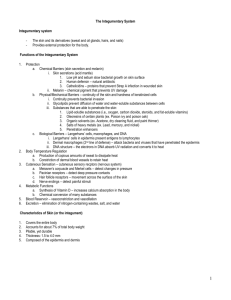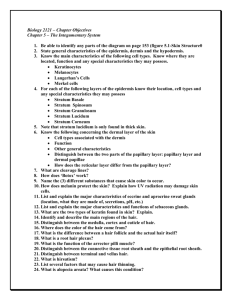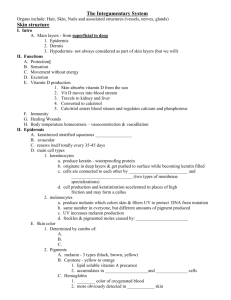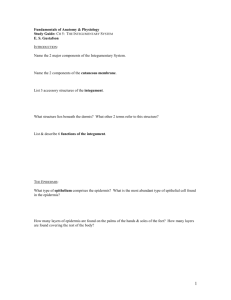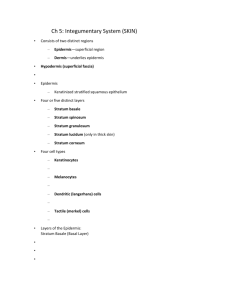Label a diagram of the skin - Mrs. Sanborn's Science Class
advertisement
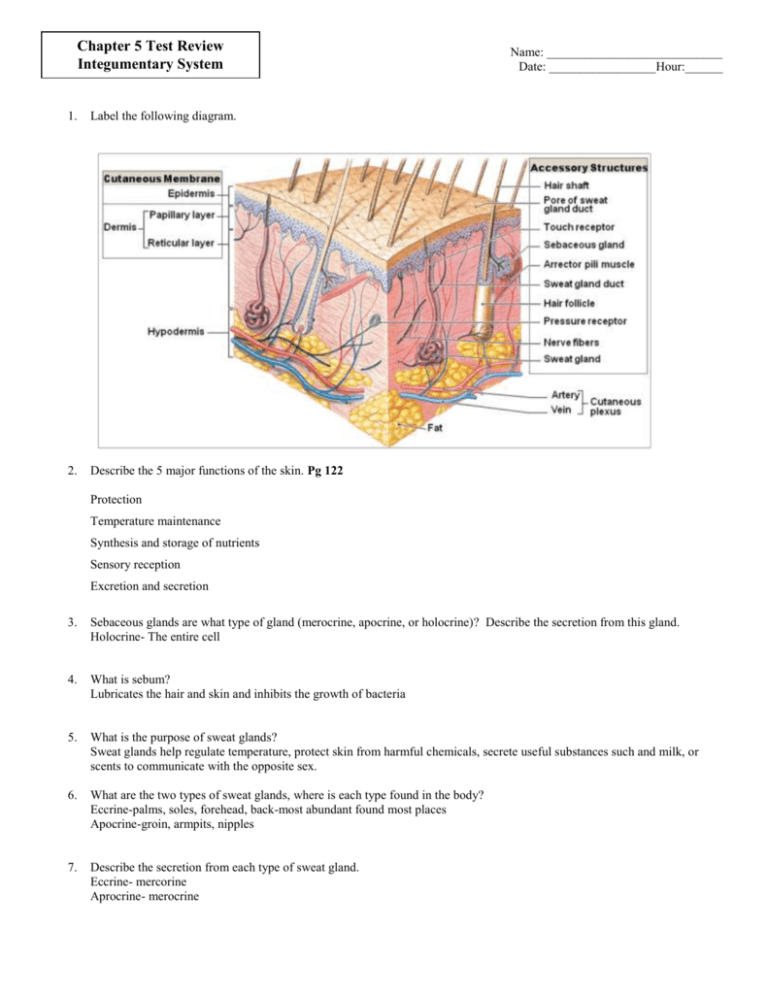
Chapter 5 Test Review Integumentary System 1. Label the following diagram. 2. Describe the 5 major functions of the skin. Pg 122 Name: ____________________________ Date: _________________Hour:______ Protection Temperature maintenance Synthesis and storage of nutrients Sensory reception Excretion and secretion 3. Sebaceous glands are what type of gland (merocrine, apocrine, or holocrine)? Describe the secretion from this gland. Holocrine- The entire cell 4. What is sebum? Lubricates the hair and skin and inhibits the growth of bacteria 5. What is the purpose of sweat glands? Sweat glands help regulate temperature, protect skin from harmful chemicals, secrete useful substances such and milk, or scents to communicate with the opposite sex. 6. What are the two types of sweat glands, where is each type found in the body? Eccrine-palms, soles, forehead, back-most abundant found most places Apocrine-groin, armpits, nipples 7. Describe the secretion from each type of sweat gland. Eccrine- mercorine Aprocrine- merocrine 8. The epidermis is avascular, so how do the cells of the epidermis receive nutrition? Dermal blood vessels 9. What are finger nails made of? Dead keratinized cells 10. What nutrient is produced in the skin? What is its function in the body? When exposed to the UV radiation the epidermal cells convert a cholesterol related steroid to Vitamin D 3. This vitamin is then changed in the liver to a hormone called calcitriol which is necessary for absorbing calcium and phosphorus in the small intestine…and strengthen the skeletal bone system. 11. Describe each layer of the epidermis in the following table, include the following information: a. Shape of the cells b. Any special cells that may be present in the layer Stratum corneum-squamous, dead keratinized cells Straum lucidum-squamous, keratinized cells, layer is clear, only found in thick skin Stratum granulosum- becoming squamous shaped, filling with keratin Stratum spinosum- polyhedral shaped, daughter cells Stratum basale-cuboidal/columnar, melanocytes present, mitosis is active 12. Describe how a cell changes as it moves from the bottom layer of the epidermis to the top layer. 13. Where are melanocytes found? What is their function? Stratum basale layer-deepest epidermal layer. To produce melanin, pigment in the skin. 14. Describe the 3 types of skin cancer. Squamous cell carcinomaBasale cell carcinoma Malignant melanoma- 15. What is a first degree burn? What layers of the skin does it affect? Superficial burn-only disrupts the epidermis, causes swelling, redness and pain 16. What is a second degree burn? What layers of the skin does it affect? Partial thickness burn-disrupts epidermis and portions of the dermis, can form blisters, swelling and pain 17. What is a third degree burn? What layers of the skin does it affect? Full thickness burn-disrupts all skin layer and hypodermis, usually not painful because nerves have been damaged, charred leathery appearance 18. List three effects of aging on skin. Higher infection rate Sensitive to the sun Hair thins & changes colors Sagging and wrinkling Muscles and bones weaken Dry and scaly skin 19. Describe what hair is, how hair develops, where it is found and what its function is. Hair contains a hair follicle deep in the dermis where cell layers found in the epidermis are constantly dividing in a region called the hair matrix. Daughter cells are pushed towards the surface and eventually exit the skin to be called the hair shaft. Hair to the visible eye is dead keratinized cells. Hair is found almost everywhere in the body except palms and soles and some regions of the reproductive organs. Function is to maintain temperature and protect. 20. What steps are involved in repairing damaged skin? See page 132




